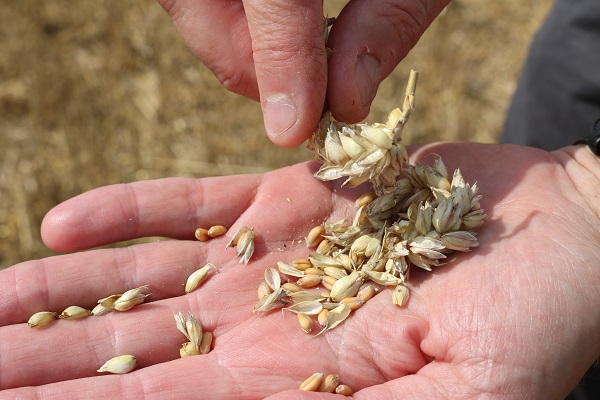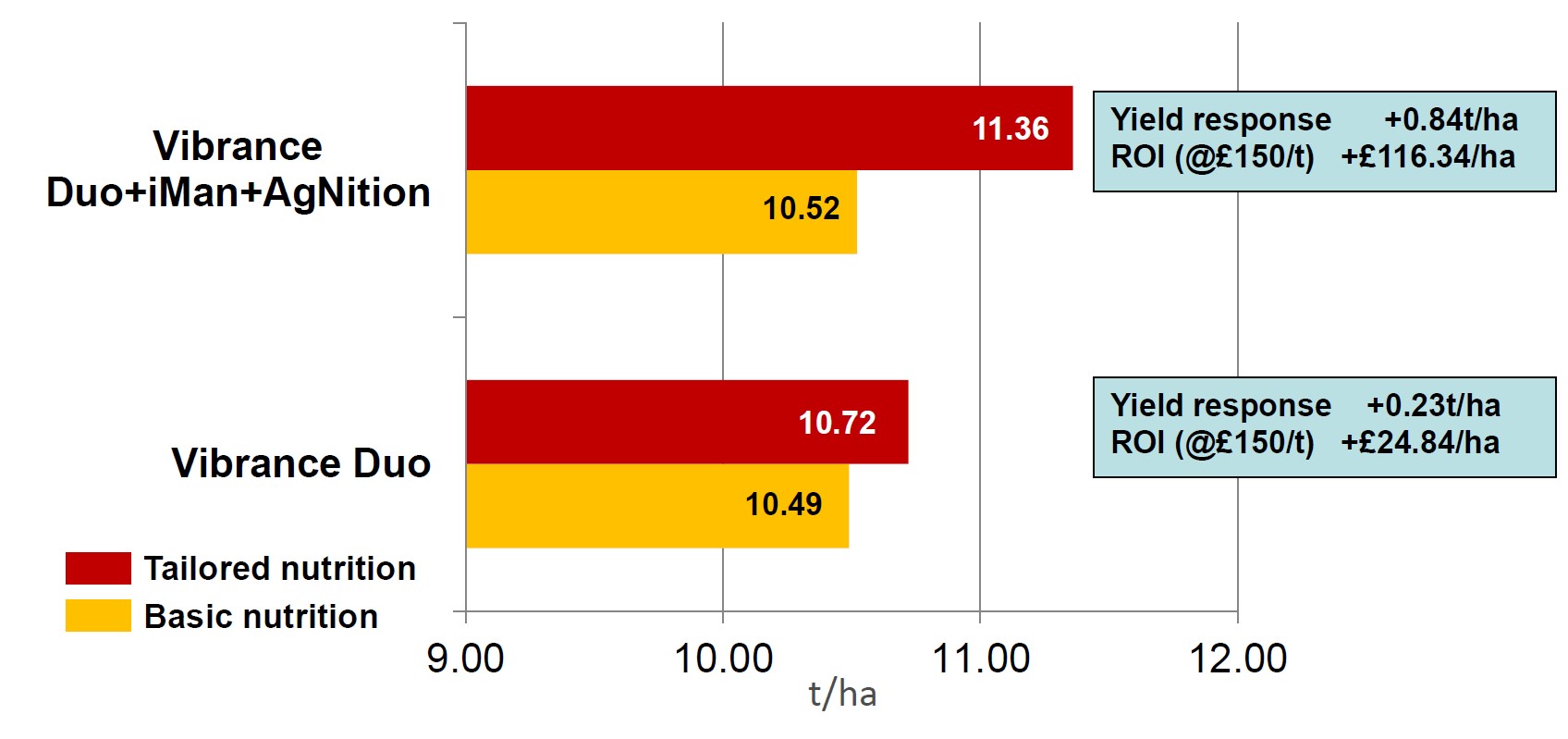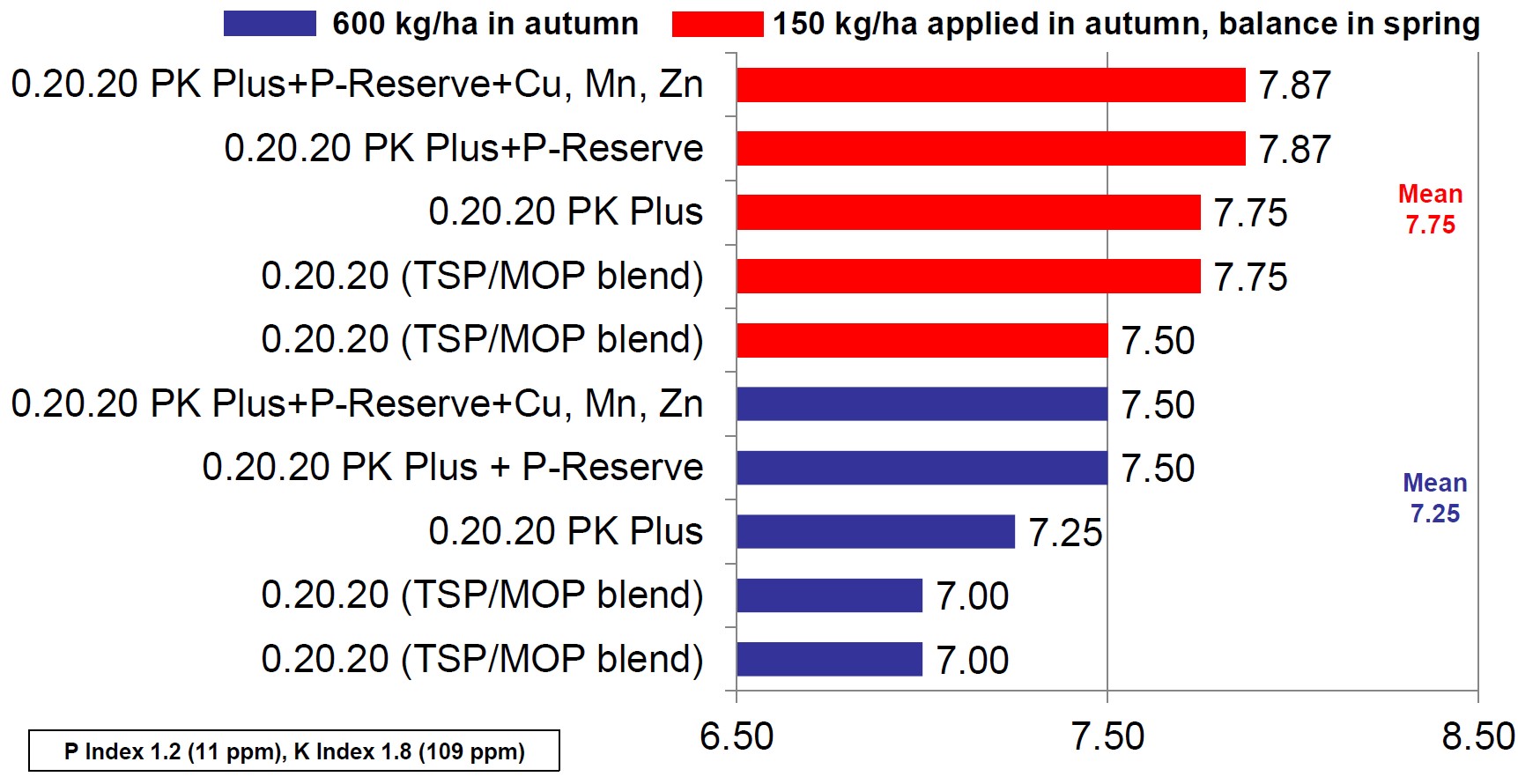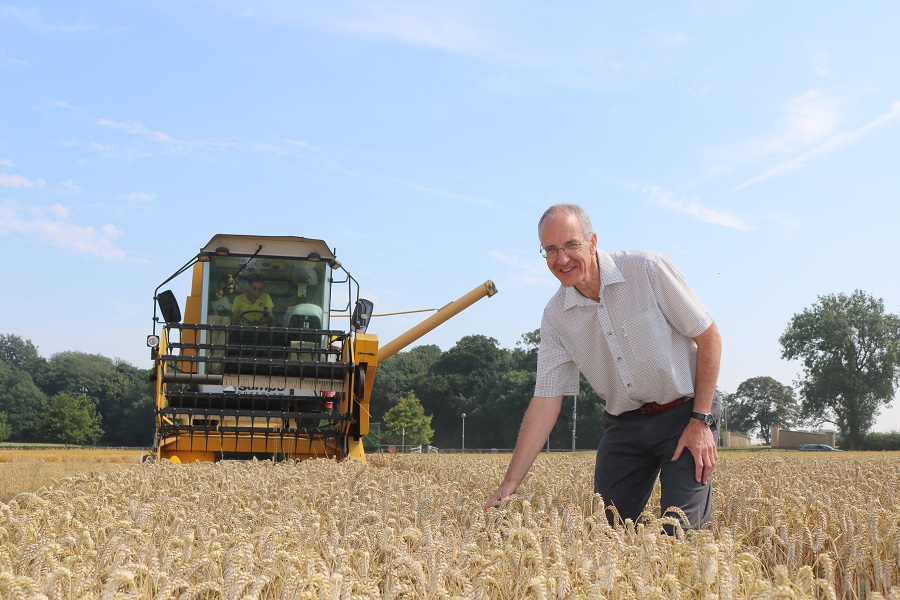Finding the right balance of nutrients to bring optimal results in every cropping situation is a daunting task. CPM gets an insight into Agrii’s tailored approach to crop nutrition and the vast array of trials data that underpins it.
If you’re not measuring the final result you can’t manage the process that got it here.
By Tom Allen-Stevens
The plot combine makes its steady way through the trials at Bishop Burton near Beverley, E Yorks, and Jim Carswell looks on – it’s an anxious moment for him as the culmination of a year’s worth of work is gathered in, carefully measured and the outcome from each plot segregated for further analysis.
He breaks off an ear, rubs it open and takes a look at what lies in his hand. As Agrii’s northern R&D manager and technical lead on its tailored nutrition programme, it’s not the plumpness nor ripeness of the grains that interests him, however. “If growers were to do one thing that could make a palpable difference to how they manage their crops, it would probably be grain nutrient analysis,” he remarks.
“What lies in these kernels tells the story of what the plant has been through since the seed was put in the ground last autumn. If you’re not measuring the final result you can’t manage the process that got it here.”

What lies in these kernels tells the story of what the plant has been through since the seed was put in the ground last autumn.
The philosophy behind tailored nutrition is to feed the plant, rather than the soil. Jim’s reviewed the vast array of data that Agrii draws on to ensure the advice growers receive results in a sustainable, as well as a productive crop, and has pulled out for CPM highlights that he believes summarise the key elements.
“You can’t look at nutrients in isolation,” he states. “There’s a synergy and complementary action that occurs at every stage of a plant’s development. A better understanding of these processes allows you to feed the plant’s needs.”
Jim explains there are three clear stages in the tailored nutrition cycle. At each, the approach is to measure what you have and assess what the plant needs:
- Comprehensive soil analyses to establish the baseline for the programme
- Enhanced tissue analyses to identify and correct crop imbalances in season
- Post-harvest grain analyses to highlight areas for future improvement.
“A useful soil analysis goes way beyond assessing for phosphate, potash, magnesium and pH,” he notes. “It should include the physical and biological aspects too.” Agrii’s recommended broad-spectrum test takes in levels of 12 macro and micronutrients while the addition of Solvita biological analysis brings in soil organic matter (SOM), carbon:nitrogen ratio and microbial biomass. This results in an overall soil-assessment score growers can use to benchmark the state of their primary resource.
And it’s in the seedbed where action to address the nutritional gaps should begin, Jim stresses. “The day you drill is the most important one in the life of the crop. It’s so critical to get the conditions right and maximise that early growth and development. The plant is then better able to deal with challenging conditions, while this stage is crucial in setting up yield potential.
“It’s a busy time, however, so it’s worth taking a step back to plan your priorities and how you’ll address plant needs.” A key area to focus on is phosphate, specifically available P, needed by the plant for early root development. Some soils contain a high content of cations, such as calcium, aluminium and iron, which can bind tightly to negatively charged phosphate anions. This means applications of triple super phosphate (TSP) and di-ammonium phosphate (DAP), for example, can be locked up in as little as two weeks.
Trials with phosphate protector, P-Reserve at the Agriifocus Swindon site in Wilts have shown a yield benefit on winter wheat of 0.54t/ha over TSP applied on its own and +0.20t/ha for DAP in soils with a P index of 2, Jim notes. This coating applied to the fertiliser granule is a strong chelating agent which binds to the cations, making the fresh application as well as inherent P more freely available.
But it’s not just the macronutrients the plant requires. Equally important are the minor elements, and it’s often difficult for the emerging plant to access these, Jim points out.
“The ideal way to feed the seedling is through combination drilling – applying the nutrient close to the seed. If you don’t have a drill with this capability, the next best is to apply just before drilling, so it’s incorporated into the seedbed.
“Fertiliser coatings are a very useful way to put readily available micronutrients close to young plants. At Bishop Burton, we’ve shown significant yield responses from using Wolftrax Mn and P-Reserve in conjunction with TSP in the seedbed, and have trials this year at Throws Farm in Essex and elsewhere to ensure the results are consistent,” he reports.
Another option to “help fill the hunger gap” are nutritional seed coatings. “These are especially useful if you’re unable to combine drill,” says Jim. “By providing key nutrients where the young roots really need them they can help combat lock-up in those early stages, especially when conditions are dry or conversely cold and wet. But it’s worth noting they can become less immediately available as the root moves away from the seed, so the benefit may be short lived if the plant can’t access what it needs thereafter.”
Agrii has run a series of trials across its iFarm network, as well as on other sites across the UK (a total of 20 sites) from 2015-2019 to assess the value of three nutritional seed treatments: iMan is an Mn dressing, AgNition gives it Cu, while Zax was used for Zn. “We had positive responses in 67%, 86% and 85% of these on-farm situations respectively. It’s worth noting, though, that certain sites tended to show a more consistent and greater positive result,” he adds.
Nutrients aren’t the only boost you can give to seedling growth. Agrii has conducted extensive trials on Take Off, and more recently Vibrance Duo (fludioxonil+ sedaxane). Take Off contains oxo pyroglutamate, said to increase C and N fixation. Vibrance Duo has been found to increase root and shoot biomass, beyond just soil and seed-borne disease control, especially later in the season, in direct-drilled situations and in second wheats.
“In trials at Bishop Burton last year, we got the best results from combining Vibrance Duo with iMan and Zax, bringing a 20% increase in ears/m² over a single-purpose dressing. Stimulating the physiological development, combined with the nutrients, brings the best results. There’s also scientific evidence that Zn may help the plant fight the effect of barley yellow dwarf virus, too,” he notes.
Coming into the spring, Jim’s a strong advocate of N-Min testing to assess levels of both available and additional available N (nitrogen in the soil that will become available to the crop in the current season). He points to iFarm data that shows a “huge variation” between sites and seasons, with total N measured down to 90cm in Jan 2017 at Bishop Burton, for example, three times higher than the same measurement taken in Jan 2019.
“But it’s not just about N in the spring, or even N and sulphur – it’s all of the main nutrients. This year was a case in point as crops limped out of a very wet winter. A bit of fresh P is a good way forward to stimulate spring growth, and K at that time of year is especially important,” he says. Trials carried out at Sancton, E Yorks, back this up.
Plant uptake of nutrients varies over the spring, which is why Jim recommends enhanced tissue testing through the season. “Historic analyses compare each nutrient against a standard guideline, regardless of growth stage or production level. The regime we’ve developed with Lancrop Laboratories over the past three years allows you to compare your results at particular growth stages with both UK average yield and Agrii best practice iFarm trial performance,” explains Jim.
Response of winter wheat to seed treatment and foliar nutrition

Source: Agrii, Culbokie iFarm, 2019. cv RGT Westminster drilled @ 390 seeds/m2.
Those who follow the tailored foliar nutrition programme, with inputs aligned to the results, typically enjoy a yield response in the range 0.17-0.93t/ha (depending on crop) according to trials on iFarms, and a return on investment that can exceed £100/ha.
So how can you tell if this tailored nutrition is actually bringing you a payback? Jim points to the combine carefully making its way through his plots. “I have the luxury of very accurate monitoring of results that gives me the data I need to pull apart different treatments. Tramline trials are always useful, although few growers will get results with the scientific rigour you expect from small-plot trials.
“That’s why grain analysis is so important – it’s a retrospective measure, but can show you where a management change has delivered an actual result.”
To illustrate, Jim points to comparison trials carried out last year on four northern iFarms across nine varieties that assessed the response to seedbed fertiliser in oilseed rape and achieved a 0.43t/ha response. “You’d expect that would result in lower nutrient concentrations through dilution, but what we actually found when we analysed the rapeseed is that nutrient levels were raised in seven of the ten we measured.
“This shows that a well managed, tailored nutrition programme brings far more to the crop than the input you apply. It brings the plant the vigour and resilience to optimise its own development and quest for resources,” he concludes.
The building blocks that lay the foundations to good growth
While all nutrients have a role at certain stages of a plant’s life, Jim picks out three micronutrients that are particularly important early on in cereals:
Manganese (Mn) is a constituent and enzyme activator for many essential enzymes controlling fundamental cellular processes. These have a key role in photosynthesis, utilising chlorophyll and proteins, and in regulating nitrate reductase activity.
Copper (Cu) is needed for pollen formation and fertility, but the plant also needs it from the moment it starts to grow as it’s an important catalyst in photosynthesis and respiration. It’s also a constituent of enzymes used in carbohydrate and protein metabolism involved in lignin manufacture, forming cell walls and resisting fungal attack.
Zinc (Zn) is a component of enzymes in sugar formation, protein synthesis and photosynthesis. It’s used for normal crop development and growth, a key nutrient in auxin production. Zn finger proteins also have an important role in DNA synthesis and gene regulation.
The value of spring top dressing
A medium soil with low P and K levels and normal SOM, a high pH at the Sancton site could interfere with macro and micronutrient uptake and availability. Leaf testing in the autumn indicated higher P and K levels where P-Reserve had been used. S levels were higher where PKpluS (0:20:20 + 27.5% SO₃) had been used compared with TSP or muriate of potash (MOP) blends. Wolftrax Cu and Zn raised levels of these nutrients in the leaf.
Mid-May NDVI measurements showed biomass was increased with PKpluS, irrespective of rate applied in autumn, while splitting the P and K over autumn and spring improved yields by an average 0.16t/ha over the five treatments.
Fertiliser response in winter wheat

Source: Agrii, Sancton, E Yorks, 2019.Crop biomass assessed at GS33 (13 May) on a scale of 1-9 (9=highest).
Agri-Intelligence update
Through the country’s most extensive agronomy research and development network, Agrii is focussed on delivering the extra value growers need in a fast-changing and increasingly challenging crop production world; value which keeps them firmly ahead in a future where overall cropping sustainability is at least as important as individual crop performance.
Following on from the series of articles developed from 2013, the company’s R&D team have provided CPM with exclusive insights into findings from some of today’s most practical crop improvement work.
This includes taking advantage of the best available variety intelligence; tailoring nutrition for winter and spring crops; employing new technologies and approaches to sustainable agronomy; and making the most of modern spring cropping.
We hope you find these insights valuable in helping you optimise your production costs; minimise your risk; take advantage of your best new opportunities; maximise your performance; simplify your management; and, above all, secure a more sustainable farming future.




